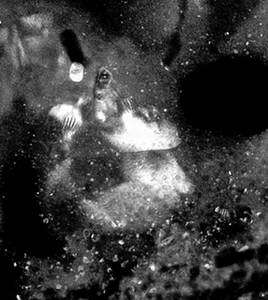Scientists Discover Mineral Comes from Ancient Supernova

NASA and University of Arizona researchers have discovered pristine mineral grains that formed in an ancient supernova explosion.
The grains were among other extraterrestrial dust plucked by high-flying NASA research aircraft from Earth's upper atmosphere after they were delivered to Earth by a comet or primitive asteroid.
Image: This is a dark field transmission electron micrograph image of the supernova olivine grain that NASA and UA scientists discovered. It is the first silicate mineral from a supernova found. (Credit: NASA Johnson Space Center, UA Lunar and Planetary Lab)
It is the first time anyone has ever discovered silicate grains, in this case olivine, from a supernova. They reveal important new information on how much material supernovae contributed to making our sun and planets, including radioactive material used in isotope age-dating techniques. The discovery also gives astrophysicists important new physical evidence they need to verify complex numerical models of supernovae explosions.
Scott Messenger and Lindsay P. Keller of the NASA Johnson Space Center in Houston and Dante S. Lauretta of UA's Lunar and Planetary Laboratory are publishing their findings in the current (June 30) issue of Science.
A supernova is a massive star that burns through its nuclear fuel -- layers of hydrogen, of helium, of carbon, oxygen, silicon, sulphur, etc. -- all the way down to the element iron. Iron is the end point for stellar nucleosynthesis -- a star can't get energy by fusing iron. When the star runs out of fuel it collapses, forms an incredibly dense neutron ball and rebounds in a cosmically violent supernova explosion. The star's successive shell-like layers of burning hydrogen, helium, carbon, oxygen, etc. undergo catastrophic mixing and eject tremendous amounts of dust and gas into the Galaxy.
Researchers don't know whether a supernova led to the formation of our own solar system, but some have found evidence that a supernova produced radioactive atoms a few million years before our solar system formed.
Messenger used a new kind of ion microprobe call the NanoSIMS to measure oxygen isotopes in the unusual grains.
Results showed that the olivine doesn't come from anywhere in our solar system, plentiful as olivine is in our solar system. "Olivine, which includes gem-quality peridot, is a very common mineral in meteorites and makes up the bulk of the mantle of the Earth," Lauretta said. "That's why it's been so hard to identify olivine that came in from another star system."
"The supernova grains have oxygen isotopic ratios that have never been seen before in meteorites or comet dust, but are predicted in astrophysical models of supernova explosions," Messenger said.
Keller identified the mineral composition using a transmission electron microscope. The NASA scientists then asked Lauretta if the grain could possibly be a supernova grain.
Lauretta used well-known supernova structure models to calculate whether the grain could have condensed directly from cooling supernova gas, as its mineral make-up suggested.
Lauretta said his computational chemical analysis matched the grain's actual isotopic and mineral composition "dead on." Messenger's isotopic ratios enabled the team to pinpoint where in the supernova explosion the grains formed.
Although there is no way to directly measure the age of the supernova olivine grain, the scientists said that mineral has remained so strikingly unaltered since it formed that it probably hasn't spent much time in the interstellar medium.
"We know from astronomical observations that crystalline silicates formed in stars are quickly destroyed by the harsh environment in the interstellar medium," Keller said, "so the survival of these grains in pristine condition is remarkable."
The scientists have pieced together the olivine's intriguing history:
-- The mineral comes from elements that mixed during the violent explosion of a collapsed, dying star about 15 times as massive as the sun.
-- The olivine crystallized when the supernova gas cooled to form dust. Numerous tiny olivine grains in one parcel of gas condensed and stuck together to form a submicron-sized olivine rock.
-- The olivine bided its time in the interstellar medium for millions of years, until it was swept up into a cold dust cloud and coated with a thin veneer of organic matter.
-- At some stage, the cloud collapsed to form our solar system, and the grain became trapped within a comet or asteroid for 4.5 billion years, the age of our solar system. The asteroid would have to be a primitive asteroid, the kind that hasn't been heated enough to destroy such presolar grains.
-- The pristine olivine was recently delivered to Earth's upper atmosphere, where it was snatched up with other interplanetary dust by an oily collector on a high-altitude NASA research aircraft
"These are the closest analogs we have now to what we think Stardust samples will look like," Lauretta said.
The NASA Stardust mission rendezvoused with comet Wild 2 in January 2004.
"We basically stuck out an ice cube tray full of aerogel as we flew through the coma, picked up a bunch of dust, and retracted the sample tray for the trip back home," Lauretta said.
Stardust returns to Earth in January 2006.
Source: University of Arizona















